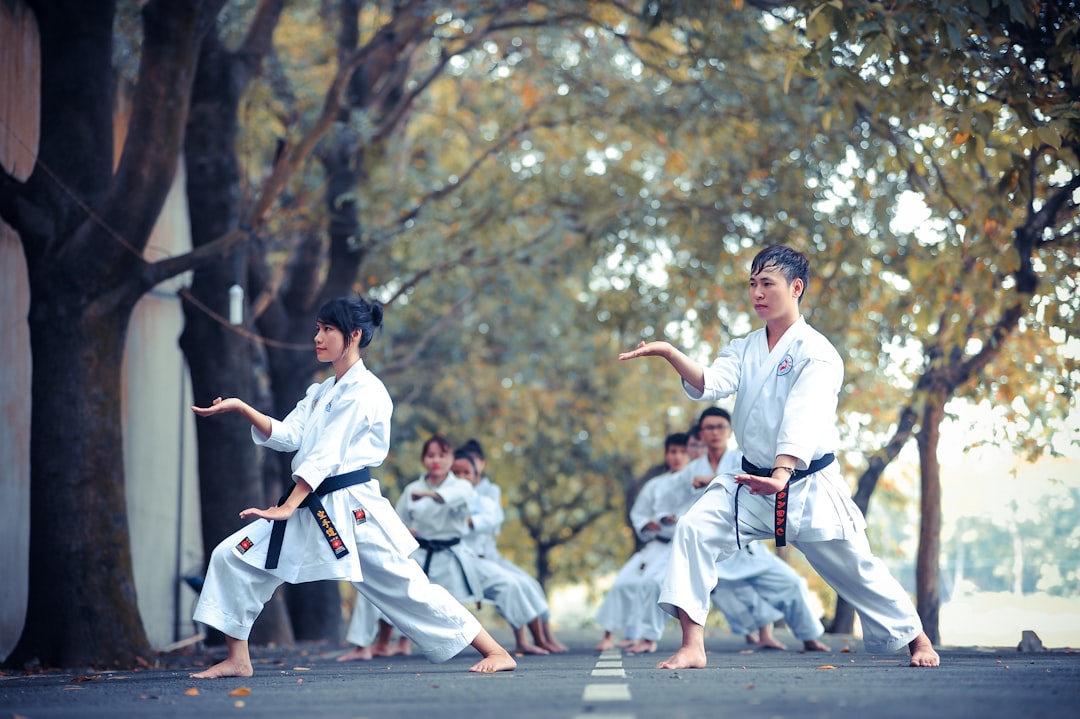When selecting a karate suit, also known as a gi, it's crucial to balance functionality with traditional standards. The ideal gi should be made from a durable yet breathable fabric like heavy cotton or a polyester blend, allowing for full range of motion while withstanding the rigors of training. It must fit precisely, offering coverage and structure without hindering movement. For sparring, reinforcements at knees and elbows offer protection, and double stitching at stress points ensures longevity. A high-quality gi ensures comfort, minimizes distractions, and enhances performance without compromising on the traditional karate practice. Beyond the gi, safety is paramount, with essential protective gear like gum shields and shin guards being critical during contact training. Accessories such as compression wear, supportive braces, and specialized footwear provide targeted support and can be tailored to individual needs. Mouthguards are mandatory for sparring to protect oral health. Hydration is key, with a durable, leak-proof water bottle necessary to maintain hydration levels throughout training. Nutrition plays a vital role in energy maintenance and muscle recovery, so a diet rich in protein and complex carbohydrates is recommended. Overall, the right combination of karate attire and accessories contributes significantly to both performance and safety within the discipline.
Embarking on a journey in karate requires more than just dedication and technique; it necessitates the right equipment. This article serves as a guide for aspiring martial artists to equip themselves with the essential items that will enhance their training experience. We’ll explore the critical components of a quality karate suit, known as a ‘keikogi,’ its material properties, and proper fit to ensure optimal functionality during practice. Beyond the keikogi, we’ll delve into protective and supportive accessories that safeguard your training. Additionally, the significance of footwear in providing mobility and stability will be highlighted. Each element plays a pivotal role in a karateka’s regimen, contributing to a well-rounded and effective training session.
- Essential Gear for Karate Practitioners: The Imperative of a Quality Karate Suit
- Understanding the Karate Uniform: Material, Fit, and Functionality
- Complementing Your Karate Suit: Protective and Supportive Accessories
- The Role of Footwear in Karate: Optimal Choices for Mobility and Stability
- Additional Items to Consider for Comprehensive Karate Training
Essential Gear for Karate Practitioners: The Imperative of a Quality Karate Suit

Choosing the right karate suit is a critical aspect for any practitioner looking to engage in this disciplined martial art. A quality karate gi, which is the traditional uniform worn in karate, not only provides comfort and flexibility but also adheres to the standards set by various karate organizations. When selecting a karate suit, one should consider the fabric’s weight, weave, and durability. Does the material offer the right balance between breathability and sturdiness? Is it heavy enough to provide coverage and structure without being overly restrictive? A well-fitted karate gi should allow for full range of motion, enabling practitioners to execute techniques with precision and control. It’s not just about the aesthetics; the suit must be functional, providing the necessary protection during sparring while allowing the instructor to assess form and stances clearly. Additionally, the suit’s construction should be robust enough to withstand the rigors of regular training. Can it hold up to repeated throws, strikes, and falls? These are the questions every karateka should ask when investing in their essential gear. A quality karate suit is an investment in your martial arts journey, ensuring that you can focus on mastering the art rather than being hindered by subpar equipment.
Understanding the Karate Uniform: Material, Fit, and Functionality

When preparing for a karate practice or competition, selecting the appropriate karate suit, known as a gi, is paramount. The material of the gi should be durable and comfortable, typically made from a heavy cotton or polyester blend that allows for ease of movement while withstanding the rigors of training. Does the fabric breathe well to manage perspiration during intense workouts? Yes, a high-quality gi will have a breathable design to help regulate body temperature and keep the practitioner comfortable throughout their training sessions.
Furthermore, the fit of the gi is crucial; it should not be too tight or too loose. A well-fitted gi ensures that it stays in place during various karate moves, providing no distractions or discomfort. Is functionality a priority in your choice of gi? Absolutely, as the best options feature reinforced knees and elbows for longevity and may include additional details like double stitching at stress points to enhance durability and support. These features are designed to withstand the physical demands of karate, ensuring that practitioners can focus on perfecting their techniques without worrying about their attire.
Complementing Your Karate Suit: Protective and Supportive Accessories

When preparing for your karate practice, ensuring that your attire is both fitting and appropriate is key. A karate suit, also known as a gi, is the standard uniform for practitioners, designed to allow for ease of movement while maintaining a sense of discipline and unity within the dojo. Beyond the gi, there are accessories that can complement and enhance your training experience. Do you require additional protection during intense sparring sessions? Consider protective gear such as gum shields or shin guards to safeguard against injuries. Are you seeking to support specific body parts to improve performance or prevent strain? Compression wear and supportive braces can be beneficial for areas like the wrists, ankles, or back. Proper footwear, such as karate shoes or dojo moccasins, provide traction and cushioning on different surfaces, which is crucial for maintaining balance and stability during practice. Additionally, hand protection in the form of mitts or padded gloves can be used during heavy bag work to prevent callous build-up and maintain the integrity of your punches.
In terms of supportive accessories, focus on items that cater to your individual needs as a karateka. Do you have any existing conditions or are you looking to optimize your strength and flexibility? Knee braces can offer stability during kata performance or intense kumite bouts, while wrist supports can aid in maintaining form during techniques like wrist locks or strikes. Hydration is also a critical aspect of training, so a durable, spill-proof water bottle is essential to keep you hydrated throughout the session. Remember, the goal is to enhance your practice without compromising the traditional nature of karate training. What accessories you choose should align with the principles of karate, supporting and protecting where necessary, while still allowing for the full experience of this discipline.
The Role of Footwear in Karate: Optimal Choices for Mobility and Stability

When practicing karate, selecting the appropriate footwear—or the lack thereof—is crucial for both mobility and stability during exercises. Karate practitioners typically train barefoot to ensure a direct connection with the floor, which is essential for sensing the surface and maintaining balance. However, when training on rough or potentially contaminated surfaces, or in public areas where bare feet might not be appropriate, athletes may opt for footwear that offers protection without compromising their agility. The key is to find a balance between grip and flexibility; shoes must allow for the natural range of motion required in karate movements while providing enough support to prevent injuries. Is it better to train barefoot or with specialized footwear? The answer varies based on the environment and the individual’s preferences, but the primary goal remains to facilitate a connection with the ground that enhances performance and safety during karate practice. When training barefoot, ensure that the flooring is clean and safe to prevent any harm to the feet. If choosing footwear, select options designed specifically for martial arts, which are often flat-soled with minimal cushioning to replicate the sensation of being barefoot.
Additional Items to Consider for Comprehensive Karate Training

When preparing for comprehensive karate training, beyond the essentials like your karate suit and protective gear, there are several additional items to consider that can enhance your experience and performance on the mat. Firstly, a well-fitted mouthguard is crucial to protect your teeth and gums during sparring sessions. Are mouthguards mandatory in all karate training environments? Yes, they are an important safety measure, especially during contact drills and sparring. Additionally, athletic tape can be invaluable for supporting wrists and ankles, preventing injuries that could sideline your practice. How does athletic tape benefit a karateka? It provides support for joints that are prone to strain or injury during intense training or competition.
Furthermore, hydration and nutrition play significant roles in maintaining energy levels and recovery. A high-quality water bottle is essential to keep you hydrated throughout the training session. What type of water bottle best suits a karate practitioner? One that is durable, leak-proof, and easy to carry, allowing for regular sips without disrupting your training. Lastly, consider packing a nutritious snack or meal, rich in protein and complex carbohydrates, to replenish energy stores and aid muscle recovery post-training. How do proper meals and snacks contribute to karate performance? Proper nutrition ensures that your body has the necessary fuel and resources to perform at its best and recover effectively after each training session.
In wrapping up our exploration of what to bring for effective karate practice, it’s clear that choosing the right attire and accessories is key. A quality karate suit, often referred to as a keikogi, serves as the foundation for proper technique execution due to its specific material and fit. Complementing this with protective and supportive accessories ensures safety and optimal performance during training. The right footwear, designed for mobility and stability, further contributes to your karate practice by providing the necessary traction and support. Beyond these essentials, additional items tailored to your training regimen can further enhance your experience. Whether you’re a beginner or an experienced practitioner, outfitting yourself appropriately is crucial for embracing the discipline and physical demands of karate. Remember to prioritize comfort, durability, and functionality in all your gear choices to elevate your training sessions and achieve your karate goals.
